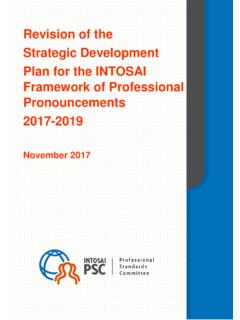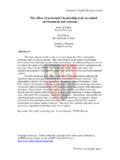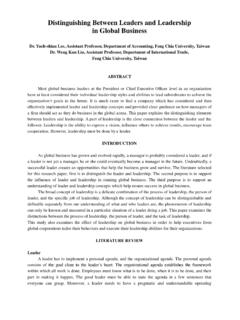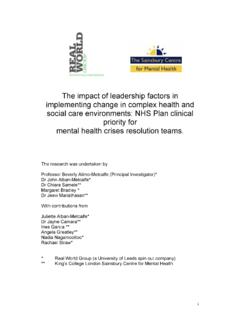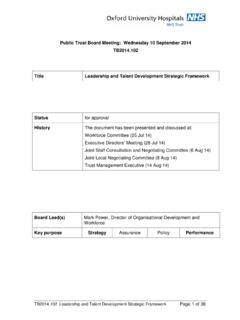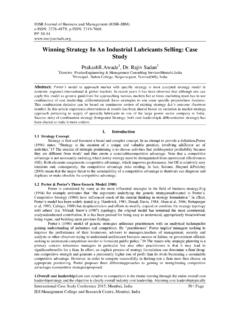Transcription of I N T O S A I Appendix to ISSAI 3100
1 The International Standards of Supreme Audit Institutions, ISSAI , are issued by the International Organisation of Supreme Audit Institutions, INTOSAI. For more information visit INT OSAI Appendix to ISSAI 3100. Building a Performance Audit Function TABLE OF CONTENTS. INTRODUCTION . 3. THE NATURE AND BENEFITS OF PERFORMANCE AUDITING 4. What is performance auditing? . 4. External benefits .. 4. Internal benefits . 5. THE CHALLENGES OF INTRODUCING PERFORMANCE AUDITING .. 6. Long term management commitment is needed.
2 6. A proper mandate is vital .. 6. The importance of building relationship with stakeholders 6. Organisational issues need to be addressed . 9. The key success factors 9. HOW TO GET STARTED . 11. Beginning small scale, with a pilot and focused themes . 11. Determining the resources needed 11. Raising awareness within the SAI .. 13. Not setting up detailed systems and procedures at this early stage .. 13. BUILDING THE CAPACITY FOR A SUSTAINABLE PERFORMANCE AUDITING. FUNCTION MAINTAING THE MOMENTUM' 14. Operational manager.
3 14. Staff recruitment and training .. 14. Performance auditing framework . 15. Communications strategy .. 17. Following-up the implementation of performance audit recommendations ..18. 2. INTRODUCTION. 1. Performance auditing greatly enriches public accountability and enables the SAI to make practical contributions to improving the efficiency and effectiveness of public administration. This guide aims to set out the benefits to an SAI from introducing performance auditing, and addresses some of the key issues to consider in introducing and maintaining performance auditing in a SAI.
4 The guide's main audience is the Head of the SAI and its senior management staff, to help them understand the requirements and challenges that need to be faced. 2. The idea is to focus on the strategic needs and general implications of introducing a sustainable performance auditing function. SAIs operate under different mandates and models, and the size of SAIs and the administrative culture vary around the world. Therefore it is not possible to produce detailed guidelines applicable to all. Thus, this document focuses on the strategic challenges concerned with the implementation process and the resources needed.
5 It also highlights the key features of performance auditing and its importance to SAIs, public administrations and society as a whole. 3. A significant number of SAIs have encountered difficulties in introducing a sustainable performance auditing function. Besides political and administrative factors, the complexity and challenge of performance auditing itself should also be acknowledged. Experience has shown that it may take years to develop this form of audit work in a sustainable way. In addition, having a strong financial and compliance auditing function does not guarantee success in performance auditing, since performance auditing is a very different discipline.
6 4. These guidelines consist of four main chapters: a) Chapter 2: presents the key performance auditing principles and describes internal and external benefits of this type of work;. b) Chapter 3: points out the main challenges of introducing performance auditing;. c) Chapter 4: highlights the key aspects to be considered when starting performance auditing; and d) Chapter 5: provides an outline of the principal issues for a sustainable performance auditing function. 5. As part of the mandated regular maintenance of the level 4 of the ISSAIs, this Appendix has been revised and, after minor editorial changes, incorporated in the updated ISSAIs 3100 endorsed in 2016.
7 3. THE NATURE AND BENEFITS OF PERFORMANCE AUDITING. What is performance auditing? 6. Performance auditing carried out by SAIs is an independent, objective and reliable examination of whether government undertakings, systems, operations, programmes, activities or organisations are operating in accordance with the principles of economy, efficiency and/or effectiveness and whether there is room for improvement ( ISSAI . 3000/17). 7. Performance auditing is about analysing and assessing the performance of government programmes or public services.
8 It is an information-based activity that requires analytical and creative skill. In contrast to financial auditing, it focuses on the activity and results rather than the accounts. And in contrast to compliance auditing, it relates mainly to the intentions behind government interventions and to the concepts of economy, efficiency and effectiveness. Basic questions in performance auditing are: a) Are the right things been done;. b) If so, are things been done in the right way; and c) If not, what are the causes?
9 8. The perspectives and the entities to be audited vary, individual departments as well as government programmes and undertakings may be audited. Some of the main differences between performance and financial auditing are summarised below. ASPECTS Performance auditing Financial auditing Assess whether government interventions or Assess whether financial operations have been Purpose measures have been conducted in accordance with carried out in accordance with legislation and the principles of economy, efficiency and regulations and whether accounts and financial effectiveness.
10 Statements are true and fair, reliable. Focus Policy, programmes, organisation, activities and Financial transactions, accounting, financial management systems. statements, and key control procedures. Economics, political science, sociology etc. Accountancy and law. Professional audit skills. Academic basis Experience of professional investigations or and relevant evaluations and familiarity with methods applied in experience social science as well as other relevant methods/skills. Methods Vary from audit to audit.

